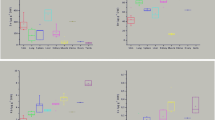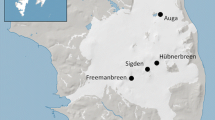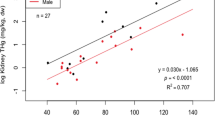Abstract
Blood and epidermal biopsies from free-ranging Tursiops truncatus captured and released during either summer or winter health assessments in Sarasota Bay, FL, were evaluated for concentrations of mercury, selenium, stable isotopes (δ13C and δ15N), and blood glutathione peroxidase activity in conjunction with routine hematology and serum chemistry panels. Major objectives were to: 1) quantify and describe relationships among mercury, selenium, glutathione peroxidase, and stable isotopes of C and N in blood and epidermis; 2) elucidate major parameters that influence blood mercury and glutathione peroxidase activity; 3) relate measures of tissue mercury, selenium, and glutathione peroxidase to specific ecological, hematological, morphological, or life history parameters, including season, sex, age, and trophic level. Mercury in both tissues examined is almost exclusively methylmercury. Epidermal concentrations of mercury and selenium reflect their respective amounts in blood, albeit at several times blood concentrations of mercury. The strong association between blood mercury and serum selenium, in conjunction with a lack of significant correlation between blood mercury and glutathione peroxidase, implies that a substantial proportion of blood mercury is affiliated with another selenium-containing moiety or is related to recent dietary intakes (e.g., trophic level, intensive fish consumption). Circulating blood mercury may be described in terms of serum selenium concentration, along with interaction terms among serum selenium, blood δ15N, and age. Current selenium concentrations in Sarasota Bay dolphins appear adequate for maintenance of blood glutathione peroxidase activity. However, dolphins evidently are subject to seasonal exacerbation of oxidative stress, which might render them more vulnerable to toxic effects of mercury.


Similar content being viewed by others
References
Adams DHR, McMichael H Jr, Henderson GE (2003) Mercury levels in marine and estuarine fishes of Florida 1989–2001. Florida Marine Research Institute Technical Report TR-9, 2nd ed. rev., 57 pp
Ancora S, Rossi R, Di Simplicio P, Lusini L, Leonzio C (2002) In vitro study of methylmercury in blood of bottlenose dolphins. Archives of Environmental Contamination and Toxicology 42:348–353
Barnes DM, Kircher EA (2005) Effects of mercuric chloride on glucose transport in 3T3-L1 adipocytes. Toxicology In Vitro 19:207–214
Bossart GD, Reidarson TH, Dierauf LA, Duffield DA (2001) Clinical pathology. In: Dierauf LA, Gulland FMD (editors) CRC Handbook of Marine Mammal Medicine, 2nd ed. Boca Raton, FL: CRC Press, pp 383–436
Brigelius-Flohé R (1999) Tissue-specific functions of individual glutathione peroxidases. Free Radical Biology & Medicine 27:951–965
Carmagnol F, Sinet PM, Jerome H (1983) Selenium-dependent and non-selenium dependent glutathione peroxidases in human tissue extracts. Biochimica et Biophysica Acta 759:49–57
Caurant F, Navarro M, Amiard JC (1996) Mercury in pilot whales: possible limits to the detoxification process. Science of the Total Environment 186:95–104
Chen C, Yu H, Zhao J, Li B, Qu L, Liu S et al (2006) The roles of serum selenium and selenoproteins on mercury toxicity in environmental and occupational exposure. Environmental Health Perspectives 114:297–301
Das K, Beans C, Holsbeek L, Mauger G, Berrow SD, Roga E et al (2003) Marine mammals from northeast Atlantic: relationship between their trophic status as determined by δ13C and δ15N measurements and their trace metal concentrations. Marine Environmental Research 56:349–365
Dehn LA, Sheffield GG, Follmann EH, Duffy LK, Thomas DL, Bratton GR et al (2005) Trace elements in tissues of phocid seals harvested in the Alaskan and Canadian Arctic—influence of age and feeding ecology. Canadian Journal of Zoology 83:726–746
Dehn LA, Follmann EH, Rosa C, Duffy LK, Thomas DL, Bratton GR et al (2006) Stable isotope and trace element status of subsistence hunted bowhead (Balaena mysticetus) and beluga whales (Delphinapterus leucas) in Alaska and gray whales (Eschrichtius robustus) in Chukotka. Marine Pollution Bulletin 52:301–319
Engle M (2005) Perspective on mercury: progress through cooperation. In: Pirrone N, Mahaffey KR (editors) Dynamics of Mercury Pollution on Regional and Global Scales: Atmospheric Processes and Human Exposures Around the World. New York: Springer Science+Business Media, Inc, pp 91–122
Fair PA, Hulsey TC, Varela RA, Goldstein JD, Adams J, Zolman ES et al (2006) Hematology, serum chemistry, and cytology findings from apparently healthy Atlantic bottlenose dolphins (Tursiops truncatus) inhabiting the estuarine waters of Charleston, South Carolina. Aquatic Mammals 32:182–195
Filho DW, Sell F, Ribeiro L, Ghislandi M, Carrasquedo F, Fraga CG et al (2002) Comparison between the antioxidant status of terrestrial and diving mammals. Comparative Biochemistry and Physiology Part A 133:885–892
Flueck W (1991) Whole blood selenium levels and glutathione peroxidase activity in erythrocytes of black-tailed deer. Journal of Wildlife Management 55:26–31
Frodello JP, Viale D, Marchand B (2002) Metal concentrations in the milk and tissues of a nursing Tursiops truncatus female. Marine Pollution Bulletin 44:551–576
Gray JS (2002) Biomagnification in marine systems: the perspective of an ecologist. Marine Pollution Bulletin 45:46–52
Hawkes WC, Keim NC (2003) Dietary selenium intake modulates thyroid hormone and energy metabolism in men. Journal of Nutrition 133:3443–3448
Hohn AA, Scott MD, Wells RS, Sweeney JC, Irvine AB (1989) Growth layers in teeth from known-age, free-ranging bottlenose dolphins. Marine Mammal Science 5:315–342
Jarrett RJ, Murrells TJ, Shipley MJ, Hall T (1984) Screening blood glucose values: effects of season and time of day. Diabetologia 27:574–577
Joiris CR, Holsbeek L, Bolba D, Gascard C, Stanev T, Komakhidze A et al (2001) Total and organic mercury in the Black Sea harbour porpoise Phocoena phocoena relicta. Marine Pollution Bulletin 42:905–911
Kirubagaran R, Joy KP (1994) Effects of short-term exposure to methylmercury chloride and its withdrawal on serum levels of thyroid hormones in the catfish Clarias batrachus. Bulletin of Environmental Contamination and Toxicology 53:166–170
Koeman JH, Peeters WHM, Koudstaal-Hol CHM, Tijoe PS, De Goeij JJM (1973) Mercury-selenium correlations in marine mammals. Nature 245:385–386
Koller LD, South PJ, Exon JH, Withbeck GA, Maas J (1984) Comparison of selenium levels and glutathione peroxidase activity in bovine whole blood. Canadian Journal of Comparative Medicine 48:431–433
Martoja R, Berry JP (1980) Identification of tiemannite as a probable product of demethylation of mercury by selenium in cetaceans. Vie Milieu 30:7–10
Minemura T, Crofford OB (1969) Insulin-receptor interaction in isolated fat cells. I. The insulin-like properties of p-chloromercuribenzene sulfonic acid. Journal of Biological Chemistry 244:5181–5188
Mori K, Yoshida K, Tani J, Hoshikawa S, Ito S, Watanabe C (2006) Methylmercury inhibits type II 5′-deiodinase activity in NB41A3 neuroblastoma cells. Toxicology Letters 161:96–101
Nigro M, Leonzio C (1996) Intracellular storage of mercury and selenium in different marine vertebrates. Marine Ecology Progress Series 135:137–143
Nishida M, Muraoka K, Nishikawa K, Takagi T, Kawada J (1989) Differential effects of methylmercuric chloride and mercuric chloride on the histochemistry of rat thyroid peroxidase and the thyroid peroxidase activity of isolated pig thyroid cells. Journal of Histochemistry and Cytochemistry 37:723–727
Pacyna EG, Pacyna JM (2002) Global emission of mercury from anthropogenic sources in 1995. Water, Air, and Soil Pollution 137:149–165
Pacyna EG, Pacyna JM, Pirrone N (2001) European emissions of atmospheric mercury from anthropogenic sources in 1995. Atmospheric Environment 35:2987–2996
Porcella DB (1994) Mercury in the environment: biogeochemistry. In: Watras CJ, Huckabee JW (editors) Mercury Pollution: Integration and Synthesis. Boca Raton, FL: Lewis Publishers, CRC Press Inc, pp 3–19
Puls R (1994) Mineral Levels in Animal Health: Diagnostic Data, 2nd ed., Clearbrook, BC: Sherpa International
St. Aubin DJ, Ridgway SH, Wells RS, Rhinehart H (1996) Dolphin thyroid and adrenal hormones: circulating levels in wild and semidomesticated Tursiops truncatus, and influence of sex, age, and season. Marine Mammal Science 12:1–13
Steel RGD, Torrie JH (1980) Principles and Procedures of Statistics—A Biometrical Approach, 2nd ed. New York: McGraw-Hill Book Company
Storelli MM, Marcotrigiano GO (2000) Environmental contamination in bottlenose dolphin (Tursiops truncatus): relationship between levels of metals, methylmercury, and organochlorine compounds in an adult female, her neonate, and a calf. Bulletin of Environmental Contamination and Toxicology 64:333–340
Trasande L, Landrigan PJ, Schechter C (2005) Public health and economic consequences of methyl mercury toxicity to the developing brain. Environmental Health Perspectives 113:590–596
NEP (United Nations Environment Programme) Chemicals (2002) Global Mercury Assessment. UNEP Chemicals, Geneva, Switzerland. Available: http://www.chem.unep.ch/mercury/Report/Final%20Assessment%20report.htm [accessed August 27, 2007]
USEPA (United States Environmental Protection Agency) (2005) The National Listing of Fish Advisories (NLFA). Available: http://www.epa.gov/waterscience/fish/advisories/2004/index.html [accessed August 27, 2007]
Venditti P, De Rosa R, Portero-Otin M, Pamplona R, Di Meoa S (2004) Cold-induced hyperthyroidism produces oxidative damage in rat tissues and increases susceptibility to oxidants. International Journal of Biochemistry & Cell Biology 36:1319–1331
Wagemann R, Kozlowska H (2005) Mercury distribution in the skin of beluga (Delphinapterus leucas) and narwhal (Monodon monoceros) from the Canadian Arctic and mercury burdens and excretion by moulting. Science of the Total Environment 351–352:333–343
Wagemann R, Trebacz E, Boila G, Lockhart WL (1998) Methylmercury and total mercury in tissues of arctic marine mammals. Science of the Total Environment 218:19–31
Wang A, Barber D, Pfeiffer CJ (2001) Protective effects of selenium against mercury toxicity in cultured Atlantic spotted dolphin (Stenella plagiodon) renal cells. Archives of Environmental Contamination and Toxicology 41:403–409
Wells RS (2003) Dolphin social complexity: lessons from long-term study and life history. In: de Waal FBM, Tyack PL (editors) Animal Social Complexity: Intelligence, Culture, and Individualized Societies. Cambridge, MA: Harvard University Press, pp 32–56
Wells RS, Rhinehart HL, Hansen LJ, Sweeney JC, Townsend FI, Stone R et al (2004) Bottlenose dolphins as marine ecosystem sentinels: developing a health monitoring system. EcoHealth 1:246–254
Wells RS, Tornero V, Borrell A, Aguilar A, Rowles TK, Rhinehart HL et al (2005) Integrating life-history and reproductive success data to examine potential relationships with organochlorine compounds for bottlenose dolphins (Tursiops truncatus) in Sarasota Bay, Florida. Science of the Total Environment 349:106–119
Whanger PD, Beilstein MA, Thomson CD, Robinson MF, Howe M (1988) Blood selenium and glutathione peroxidase activity of populations in New Zealand, Oregon, and South Dakota. FASEB Journal 2:2996–3002
Woshner V, Knott K, Wells R, Willetto C, Swor R, O’Hara T (2006) Mercury and selenium in blood of bottlenose dolphins (Tursiops truncatus): interaction and reference to life history and hematologic parameters. Paper SC/58/E24 presented to the IWC Scientific Committee, June 2006, St. Kitts and Nevis, WI, 9 pp
Woshner VM, O’Hara TM, Bratton GR, Suydam RS, Beasley VR (2001a) Concentrations and interactions of selected essential and non-essential elements in bowhead and beluga whales of Arctic Alaska. Journal of Wildlife Diseases 37:693–710
Woshner VM, O’Hara TM, Bratton GR, Beasley VR (2001b) Concentrations and interactions of selected essential and non-essential elements in ringed seals and polar bears of Arctic Alaska. Journal of Wildlife Diseases 37:711–721
Acknowledgments
The authors extend sincere gratitude to the staff of the Sarasota Dolphin Research Program based at Mote Marine Laboratory, especially to Brian Balmer and Suzanne Hofmann for help with sample collection and logistics, and to Howard Rhinehart, who helped to initiate this study through his recognition of the importance of selenium in odontocete health. We also thank Ailsa Hall for statistical advice and Nikki Greer for analytical assistance, as well as Debra Miller and Mike Castellini for manuscript review. Special thanks go to the National Oceanic and Atmospheric Administration for support through the Chicago Zoological Society and Dolphin Quest, and to Dr. Teri Rowles of the NOAA Marine Mammal Health and Stranding Response Program. This publication (O’Hara, Knott, Swor) was made possible in part by Grant Number 5P20RR016466 from the National Center for Research Resources (NCRR), a component of the National Institutes of Health (NIH). Its contents are solely the responsibility of the authors and do not necessarily represent the official views of NCRR or NIH.
Author information
Authors and Affiliations
Corresponding author
Electronic supplementary material
Below is the link to the electronic supplementary material.
Rights and permissions
About this article
Cite this article
Woshner, V., Knott, K., Wells, R. et al. Mercury and Selenium in Blood and Epidermis of Bottlenose Dolphins (Tursiops truncatus) from Sarasota Bay, FL: Interaction and Relevance to Life History and Hematologic Parameters. EcoHealth 5, 360–370 (2008). https://doi.org/10.1007/s10393-008-0164-2
Received:
Revised:
Accepted:
Published:
Issue Date:
DOI: https://doi.org/10.1007/s10393-008-0164-2




